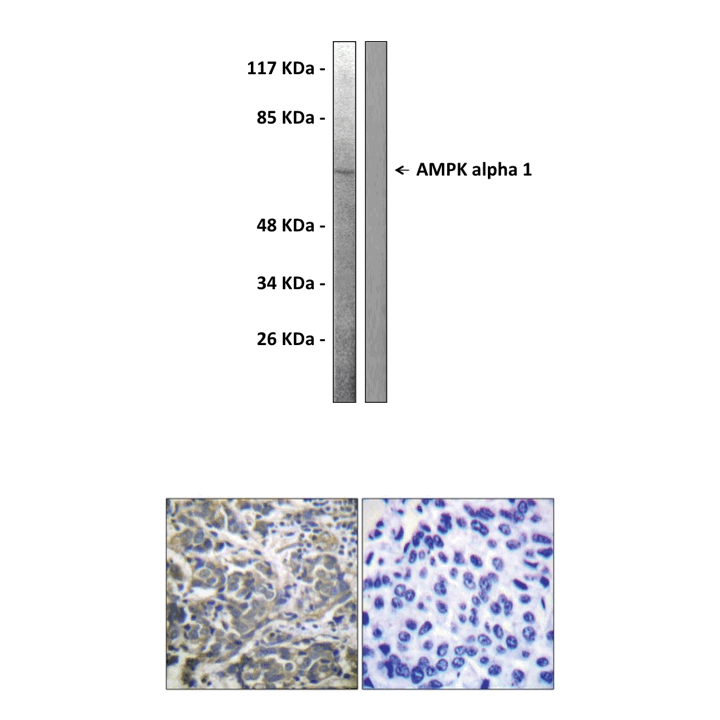Product Sheet CG1009
Description
BACKGROUND AMPK is a serine/threonine protein kinase, which serves as an energy sensor in all eukaryotic cell types. Mammalian AMPK is a trimeric enzyme comprising a catalytic alpha subunit (63 kDa) and non-catalytic beta and gamma subunits. Multiple isoforms of each mammalian enzyme exist (alpha-1, alpha-2, beta-1, beta-2, gamma-1, gamma-2, and gamma-3); each encoded by a different gene.1 AMPK activation strongly suppresses cell proliferation in non-malignant cells as well as in tumor cells. These actions of AMPK appear to be mediated through multiple mechanisms including regulation of the cell cycle and inhibition of protein synthesis, de novo fatty acid synthesis, specifically the generation of mevalonate as well as other products downstream of mevalonate in the cholesterol synthesis pathway.2 Cell cycle regulation by AMPK is mediated by up-regulation of the p53–p21 axis as well as regulation of TSC2–mTOR (mammalian target of rapamycin) pathway.3 The AMPK signalling network contains a number of tumour suppressor genes including LKB1, p53, TSC1 and TSC2, and overcomes growth factor signaling from a variety of stimuli (via growth factors and by abnormal regulation of cellular proto-oncogenes including PI3K, Akt and ERK). These observations suggest that AMPK activation is a logical therapeutic target for diseases rooted in cellular proliferation, including atherosclerosis and cancer.
REFERENCES
1. Kemp, B.E. et al: Structure 15:1161-1163, 2007
2. Zhang, B.B. et al: Cell Metabol. 9:407-416, 2009
3. Thoreen, C. & Sabatini, D.: Cell Metabol. 1:287-288, 2005
2. Zhang, B.B. et al: Cell Metabol. 9:407-416, 2009
3. Thoreen, C. & Sabatini, D.: Cell Metabol. 1:287-288, 2005
Products are for research use only. They are not intended for human, animal, or diagnostic applications.

(Click to Enlarge) Top: Immunoblotting analysis of extracts from COS7 cells, treated with Adriamycin 0.5ng/ml 24h, using Anti-AMPK α antibody. The lane on the left was treated with the Anti-AMPK α antibody. The lane on the right (negative control) was treated with both Anti-AMPK α antibody and the synthesized immunogen peptide. Bottom: Immunohistochemistry analysis of paraffin-embedded human breast carcinoma tissue using Anti-AMPK α antibody. Cells on the left were treated with the Anti-AMPK α antibody. Cells on the right (negative control) were treated with both Anti-AMPK α antibody and the synthesized immunogen peptide.
Details
Cat.No.: | CG1009 |
Antigen: | Synthesized peptide derived from human AMPK α |
Isotype: | Rabbit IgG |
Species & predicted species cross- reactivity ( ): | Human, Rat, Mouse |
Applications & Suggested starting dilutions:* | WB 1:500-1:1000 IP n/d IHC 1:50-1:100 ICC n/d FACS n/d |
Predicted Molecular Weight of protein: | 62 kDa |
Specificity/Sensitivity: | Detects endogenous proteins without cross-reactivity with other family members. |
Storage: | Store at -20°C, 4°C for frequent use. Avoid repeated freeze-thaw cycles. |
*Optimal working dilutions must be determined by end user.
Products
| Product | Size | CAT.# | Price | Quantity |
|---|---|---|---|---|
| Rabbit AMPK-Alpha 1 Antibody: Rabbit AMPK-alpha 1 Antibody | Size: 100 ul | CAT.#: CG1009 | Price: $384.00 |
